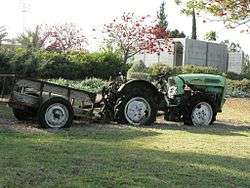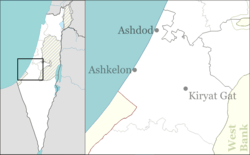Netiv HaAsara
Netiv HaAsara (Hebrew: נְתִיב הָעֲשָׂרָה, lit. Path of the Ten) is a moshav in southern Israel. Located in the north-west Negev, it falls under the jurisdiction of Hof Ashkelon Regional Council. In 2019 it had a population of 891.[1]
- For the settlement in the Sinai, see Netiv HaAsara, Sinai.
Netiv HaAsara נְתִיב הָעֲשָׂרָה | |
|---|---|
 A tractor near Netiv HaAsara's concrete shelter | |
 Netiv HaAsara | |
| Coordinates: 31°34′15.24″N 34°32′21.84″E | |
| Country | Israel |
| District | Southern |
| Council | Hof Ashkelon |
| Affiliation | Moshavim Movement |
| Founded | 1982 |
| Founded by | Netiv HaAsara (Sinai) residents |
| Population (2019)[1] | 891 |
| Website | www.netiv-10.co.il |
History
The moshav was founded in 1982 by 70 families who were residents of the former Israeli settlement of Netiv HaAsara in the Sinai Peninsula, which was evacuated as a result of the Camp David Accords.[2] The original moshav had been named for ten soldiers that were killed in a helicopter accident south of Rafah in 1971, and was originally named "Minyan".[3]
After the Israeli disengagement from Gaza in 2005, Netiv HaAsara became the closest community in Israel to the Gaza Strip, located 400 meters away from the edge of the Palestinian town of Beit Lahiya. At the southern edge of the village, a car park was converted into an Israel Defense Forces base and tanks were deployed. An electric fence was erected to stop infiltration attempts from Gaza, and three concrete walls were built against potential Palestinian snipers.[2]
The moshav was a target of Qassam rockets,[2] Katyusha rockets,[4] and mortar shellings,[5] In 2007, the Popular Resistance Committees sent two guerrillas to infiltrate the moshav, but they were killed by the IDF.[6]
Dana Galkowicz, a 22-year-old Israeli-Brazilian woman, was killed on 14 July 2005 at Netiv HaAsara by a Qassam rocket. On 10 March 2010, a Thai worker was killed. [7]
Tourism
In the 2010s Netiv HaAsara became an increasingly popular tourist attraction among foreign visitors drawn to a community where ordinary life continues despite constant threat of rocket attacks from neighboring Gaza. An observation platform designed by architect Zvi Pasternak - expected to open in spring 2018 - will enable visitors to see Gaza City to the south and Ashkelon to the north.[8]
References
- "Population in the Localities 2019" (XLS). Israel Central Bureau of Statistics. Retrieved 16 August 2020.
- Berg, Raffi (November 18, 2005). "Israelis on the frontline with Gaza". BBC. Retrieved April 18, 2019.
- El'azari, Yuval, ed. (2005). Mapa's concise gazetteer of Israel (in Hebrew). Tel Aviv: Mapa Publishing. p. 381. ISBN 965-7184-34-7.
- Katz, Yaakov (May 16, 2006). "Katyusha rocket fired at Netiv Ha'asara". The Jerusalem Post. Retrieved April 18, 2019.
- Hadad, Shmulik (January 31, 2008). "8 mortar shells hit community of Netiv HaAsara". YNet News. Retrieved April 18, 2019.
- Greenberg, Hanan (August 25, 2007). "IDF forces foil terror plot". YNet News. Retrieved April 18, 2019.
- Galkowicz, Natan (2007-08-25). "Victims of Terror". Foreign Ministry of Israel. Retrieved 2010-03-25.
- Gilad, Moshe (20 January 2018). "Tourism Boom Takes on a Whole New Meaning as Thrill-seeking Adventurers Flock to Israel-Gaza Border". Haaretz. Retrieved 21 January 2018.
External links
- Official website (in Hebrew)
- Urquhart, Conal (2005-11-09). "Israelis living near Gaza seek aid to relocate after rocket fire". The Guardian. Retrieved 2008-10-01.
- Ben Simon, Daniel. "'This is really not what we hoped for'". Haaretz. Retrieved 2008-10-01.